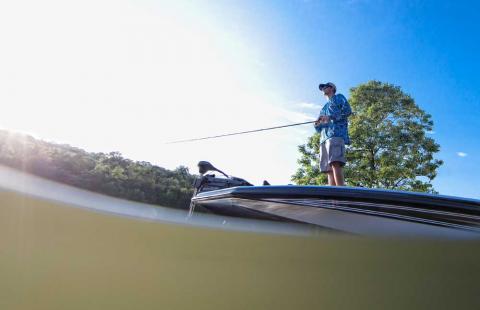Gerald Almy | Originally published in GameKeepers: Farming for Wildlife Magazine. To subscribe, click here.

When my family moved back to our home state of Virginia after a period of living in Texas, we found a property that had more land than we needed but was just too beautiful to pass up. Lying in the Shenandoah Valley at the base of Little North Mountain, it had two live streams, two springs, and a mixture of cedars and open fields in the low area and oaks, ash and pine in the foothills.
We only wanted enough land for a little privacy, a few food plots and maybe a pond—perhaps 25-30 acres. But we wound up with over a hundred. With the home in Texas not sold, and now land in Virginia to pay for, plus the log cabin we were having built on it, I was not in a mood to spend any more money. But once the log home was up, the well drilled and electricity hooked up, we found out we had a problem…and it was a problem only money could fix.

The well pumped strong at "15 gallons per minute," but much to our dismay the water was "silty." The contractor assured us this was not unusual at first, “just wait and it will clear up.” Long story short... it didn’t. And while I wasn’t in the mood to spend money, my wife, Becky, wasn’t in the mood to take showers and do laundry with slightly brownish water—even though I tried to tell her a little silt was healthy and made her skin smooth. She didn’t go for that.
As unhappy as I was to spend the money, we bit the bullet after a few weeks and drilled a new well. It didn’t have the volume of the first one but soon poured out crystal clear. The wife was happy. And the more I got to think about it, that extra $3,000 may have been the best money I ever spent.
I never would have talked Becky into spending that much just to have a spare well to water my food plots during dry weather, but the way it worked out the spare well was there and I figured it might as well be put to use. In 22 years, I can think of only two summers where that well has not saved a number of my best plots from totally withering away. As in many areas of the country, we have been in a prolonged dry season where drought-proofing our food plots is essential. The well has meant the difference between a shriveled, struggling plot and lush green one that attracted and nourished deer.
Of course, as I planted more plots and larger ones, I couldn’t water them all. However, I could reach some pretty far away. First I ran a few hundred feet of hard plastic one-inch hose from the well - then connected it down to regular garden hose. I experimented with many types of sprinklers but settled on a metal, circular, heavy-duty one that wets an area up to 100 feet across and allows me to keep several plots lush and green even when some months pass without an inch of rain. Those pampered plots offer succulent clover and chicory for the deer to eat, and equally important, take some pressure off the struggling dry plants that I can’t reach with the sprinkler.
You can even use this “special treatment” of specific plots as a hunting strategy to concentrate deer activity near a few of your early season stand sites. If some of your plots are lush and green and the others are withered and struggling, you know which ones bucks are likely to be visiting. If you decide to use this selective watering approach, make sure the plots you select favor early-season wind patterns and approach routes for accessing and hunting the plot.
Sprinklers won’t replace rain, but they do buy you a little time…maybe just enough time for the plants to hold out until some showers, or better yet, a heavy rain arrives. I’ve connected as many as 12, 50-foot hoses. With a stronger well, you might be able to stretch that even a little farther. If the well is located in the right location you can cover food plots within a 200-yard reach.
Sprinkler heads come in a variety of styles including impact, gear drive and wobblers. I prefer the impact variety because they seem most rugged and durable. You can also find a variety of sprinklers at places such as Lowe’s and Home Depot or online at sites such as Bigsprinkler.com.
Wheeled cart, sled-based and tripod mounts are other options. You can also install timers if you want to water your plots at regular intervals but can’t be there. An Orbit Timer from Big Sprinkler ($39) allows you to set the start time, duration, and frequency of watering without even being on site.
Maintaining strong pressure for a Some gamekeepers may balk and think this is an outrageous expense, but consider some of the other expenses you have and it might not seem quite so bad—fertilizer, seeds, herbicides, $10-100,000 tractors, implements, taxes, road maintenance, not to mention the big one—the land itself.
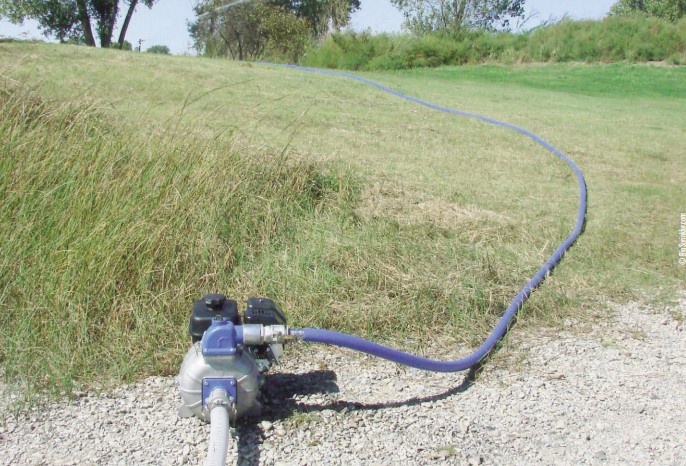
Pump Systems
If you don’t have a spare well or locations where you can drill one near your plots, another option is to use pump and irrigation type systems offered by companies such as They have systems including, "pump, intake and output hoses, with sprinklers," starting as low as $995 - this system would allow you to water plots using ponds, lakes, rivers or creeks. Their base model includes a 6.5 hp Kohler pump, 2-inch suction hose with strainer, and 1½ inch discharge hose. Both hoses come with convenient quick-connect couplers.
I’ve rented and experimented with this type of system using a two-acre pond on my property. It has the advantage of using larger hoses and strong pumps that will saturate a plot more quickly than the "well, garden hose and sprinkler" method. Even with the lowest-priced Big Sprinkler system, you can thoroughly drench a large food plot in a few hours. If you don’t want to invest a “grand” or more on such a setup, rentals are a good option during intense short-lived droughts. Make sure you prime your pump properly before starting (if required) and check periodically to make sure weeds haven’t clogged the intake hose.
Strategies
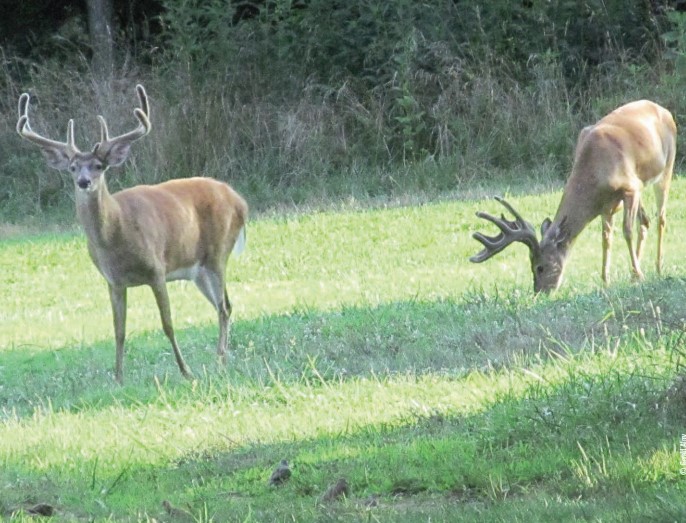
Whichever system you use, be sure to soak the plot thoroughly, then move the sprinkler to a new area or new plot, rather than superficially dampening the plot then rushing to the next one. It takes a while during dry periods to even soften the soil enough so that it begins to absorb and soak into the soil. Only after that does some of the applied moisture reach the critical area of the roots that is most important.
Because of the need to thoroughly soak a plot, I suggest selecting some, or select "areas" to focus on and don't try to water every square inch of all of your plots. This tends to transfer deer feeding pressure to the areas you water and give the others a break while they are under stress. Again, this means hunting becomes easier because you cut down on the potential areas the animals will want to concentrate on.
When to Water Your Food Plots
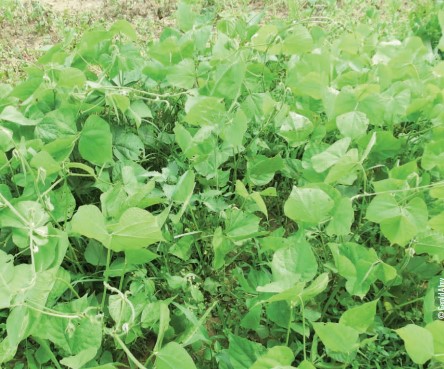
withstand a bit of drought is a great choice for a warm season
planting.
Watering can be done any time rains are scarce and plots are struggling from the heat and dryness, but using sprinklers is particularly valuable in several specific circumstances. One situation where watering helps dearly is when it’s hot and dry and you've developed a weed and/or grass problem in a clover plot so it requires mowing, but no rain is predicted. If you have sprinklers available, you can mow the weeds and grasses and some of the clover itself that might be flowering, then water the plot immediately afterward. If you weren’t able to water, it wouldn’t be wise to mow under these conditions because the plants are stressed. That, in turn, would allow the weeds and grasses to grow taller, compete with your crop, and potentially go to seed and cause a bigger problem later. Another time sprinklers come in handy is if you are putting in a new plot and no rains are on the horizon. You can sow the seed, water it so it germinates, then nurse the new crop along with periodic watering until rain arrives. This allows you to put each type of seed in at the optimum calendar date for that plant and not have to wait on Mother Nature.
Alternative Strategies
If it’s not feasible to drill a well or use a pump irrigation system, there are several steps you can still take to help plants survive the drying, parching summer weather. First off, plant some drought tolerant seeds or mixtures such as lablab, Texas Draw or chicory. Secondly, make sure you do a soil test for all your plots and apply the appropriate amount of lime and fertilizer, including micronutrients such as boron and manganese and major elements like sulfur as well as the common nitrogen, phosphorous and potassium requirements. Appropriate fertilizer and a good pH reading will result in the strongest plants, and those are the ones most capable of withstanding and surviving dry spells.
Weed control is also important. You want the limited amount of moisture available to go to your crop, not to competing grasses and weeds. Keeping your deer herd in check is another way to help food plots survive dry spells. Limited, spread-out grazing pressure is fine, but heavy utilization by deer while a crop is already stressed and growing poorly from dry conditions may completely destroy it.
Another strategy I like to employ is to put plots in where they get the most morning sun, rather than late afternoon sun. Look for north and east-facing fields on gentle slopes or areas with tall trees on the south and west sides that will shade the plots some from the hottest late day sun.
Conclusion
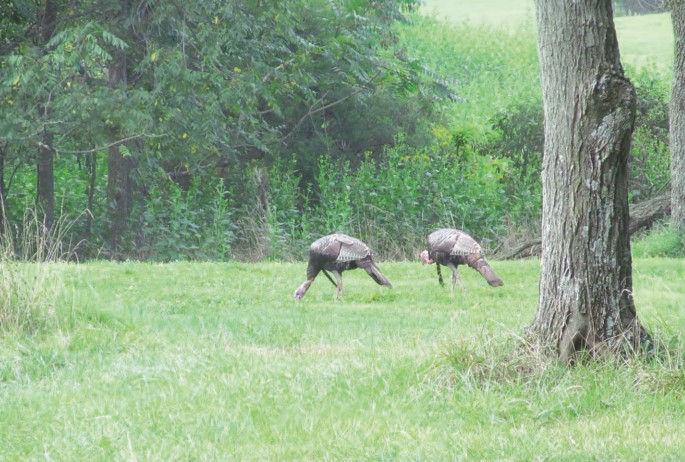
Once you’ve taken these steps, though, give some serious thought to saving up to invest in a well and sprinklers or pump irrigation setup – something a bit more permanent. You can sit back and let the drought make you miserable, or you can do something about it.
I was “fortunate” that the silt in the first well we drilled for our home forced us to dig a second one. That gave me an “unneeded” source of water that I could use for my plots. I think eventually I would have taken that step anyway or purchased a pump irrigation system. Oh, and by the way, that silt-tainted first well that we dug and had to replace, the one I now use to water my plots... it cleared up about two weeks after we dug the second well. I now irrigate my plots with water as clear as vodka!

















